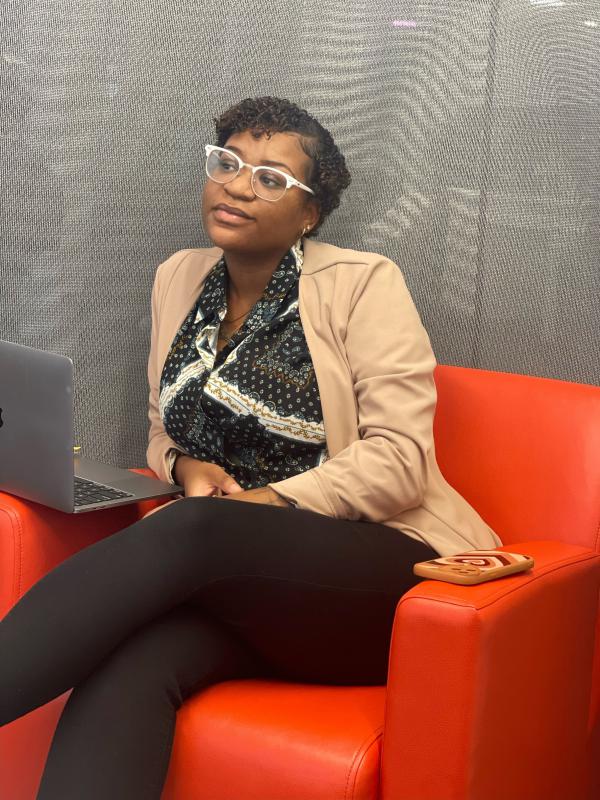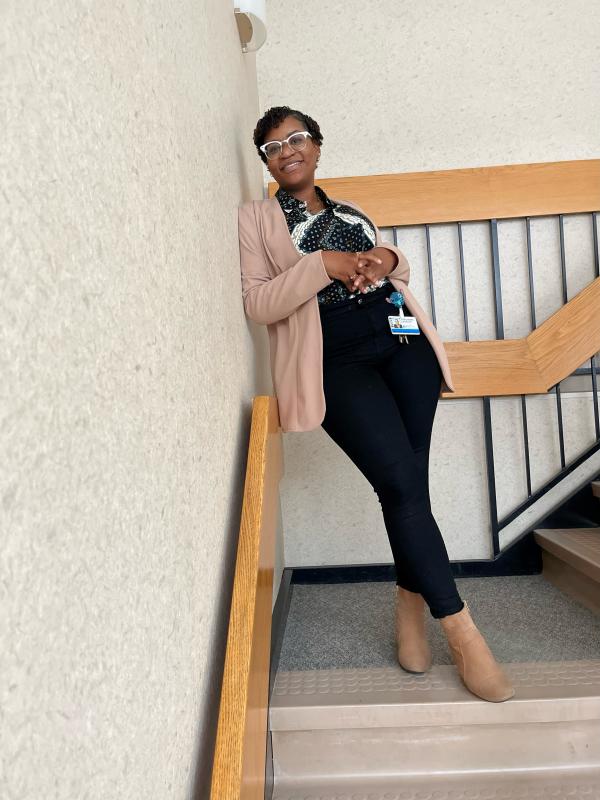BOSTON, MA – At Brigham and Women’s Hospital (BWH) in Boston, Cassandra “Cass” Georges, a 26-year-old UMass Amherst graduate, plays an instrumental role in implementing a groundbreaking care model that is transforming patient care in medicine and eliminating an inequity in the hospital’s Emergency Department.



In 2015 a study found that over a 10-year period, on average, fewer Black and Hispanic heart failure patients were admitted to a specialty cardiology unit that improves patient outcomes. Subsequently doctors developed the Healing ARC framework, a race-conscious intervention that curtails racism in the admissions process and improves accountability.
The “ARC” in Healing ARC stands for acknowledge, redress and closure. Georges, who majored in public health at UMass, coordinates the community engagement that is central to completing the ARC. She is a program manager in the hospital’s Office of Ideas (Inclusion, Diversity, Equity and Social Justice), which champions and engages in health equity work with a core mission of addressing and reducing health equity barriers, particularly in underrepresented and vulnerable communities.
With a license to be creative granted by her supervisors, Georges organizes the “Wisdom Council,” a group of neighborhood leaders whose constituents are impacted by racism at the hospital. She explains why community engagement is such a vital part of the Healing ARC and restorative health equity work.
“We are reaching out to community members so we can leverage their input and insights in the hospital’s decision making,” Georges says. “There are too many times when attempts to address health disparities are designed at the top of the bureaucracy and ignore community views and opinions. Historically, instead of going to harmed populations and including their thinking in the remedy, they are completely cut out of picture.”
With the Healing ARC, it is starkly different, she says. “The community engagement is what propels this intervention forward in an inclusive, meaningful way.”
Stage one of the Healing ARC framework requires providers and institutions to acknowledge that racism contributes to inequitable health outcomes. Stage two is designed to redress the harm by providing redress to the harmed population, including opening access to services and care historically denied. Stage three is to facilitate closure through reconciliation and agreement that the harm has been redressed.
“Without the community, we cannot complete the Healing ARC. Completing the ARC is centered around restorative justice so it is essential there are other voices besides the culpable institution” Georges says. “We really need the community to be engaged with what the hospital is doing. This is the only way we can counter the pain and suffering that may have been caused by the acts of racism that kept Black and Hispanic patients out of the cardiology unit.”
She finds it “transformational” that the Healing ARC forces engagement with external partners that are authentic outside voices, strikingly different than an echo chamber in an institution.
“We have had some robust conversations centered around the three stages of the framework and have broken them up into their respective categories to begin identifying the best path to redress,” Georges says. “We dug deep to discuss what the acknowledgement of institutional racism even looks or sounds like because we honestly didn’t know where to begin, and honesty is the grounding piece to the healing ARC framework.”
For Georges, her “love” and “passion” for advocacy comes from enduring a difficult journey. She spent her childhood in foster homes spread across Massachusetts, as a product of the state’s child welfare system. “I grew up all over Massachusetts,” she recalls. “As many in foster care I was placed in many different homes. So, I think my love and my passion for advocacy stemmed from that, from kind of being young and having to figure out how to navigate the world for myself, and for other kids like myself. We were all trying to battle this system that operated against us and silenced us all our lives. So that is where my drive comes from.”
Georges relates her childhood journey to the importance of leveraging community trust through the Wisdom Council.
“Throughout my life. I had this anxiety centered around authority,” she says. “Because when you are in the child welfare system, they tell you what to do, where to go, when to go, you are removed from making your own decisions until you age out of the system. They monitor everything. You do not really have much autonomy over yourself. Your voice as you once knew it is stripped from you. And so, for me, the biggest thing is protecting people’s dignity, autonomy and amplifying or creating spaces for their voices to be heard. As I have grown, I have had to relearn what trust means for myself and carry that with me in the career field I am in. As a result, I have been able to create my own chosen family, and I bring that sense of community and healing with me into professional spaces, it drives the patient centered work that I do.”
What eased her journey, she says, was befriending teachers who became important mentors and helped guide her. She attended the Urban Science Academy in West Roxbury for high school and participated in a Student to Success Jobs program, which, ironically landed a job as a summer intern at BWH. Though she acknowledges it was difficult trying to plan her future without her parents, she credits a college access counselor and her senior year teachers with advising her to apply to college as an independent, which paved the way for her to attend UMass.
“I think it’s important that I’ve taken my past and I’ve turned it into something that I can be proud of,” she says.
Dr. Bram P. Wispelwey, an Instructor in Medicine at BWH and at the Harvard T.H. Chan School of Public Health, credits Georges with defining what authentic community engagement can be. “With the skills of both an orchestrator and conductor, Cass is brilliantly co-developing and convening a community Wisdom Council to imagine what institutional accountability looks like when it comes to pursuing health equity,” Dr. Wispelwey says. “Perhaps her greatest attribute is her remarkable ability to distill the Wisdom Council’s community perspectives into direct action steps within the hospital.”
Further, Dr. Wispelwey, who helped develop the Healing ARC framework, says: “Cass operates at the level of a co-creating, thought partner who is actively bringing herself and her experience into the work. Her deep investment in the project, which includes building out presentations and coordinating numerous conversations at all levels of BWH, shines through in the Wisdom Council’s own participation and excitement.”
Dr. Wispelwey cites Georges’ organizing abilities for advancing implementation of the Healing ARC. “Cass has moved Healing ARC from a theoretical concept to a concrete reality,” he says. “She has been instrumental in building the Wisdom Council into a dynamic, idea-generating community.”
For instance, at an upcoming session the Wisdom Council will meet with directors of the hospital’s non-physician employees, individuals working as receptionists, security, telephone operators, and more. The people on the frontlines. Georges wants to work out arrangements so they can hear the concerns of these works, learn if they have experienced racism at the hospital and what they perceive can be done about it.
“These are the people who live within the harmed communities,” Georges says. “These are people we need to bring into the conversation, hear their opinions, talk to them, and find out what they are thinking so that we can amplify their voices as we move through the ARC framework. A large piece of the puzzle is missing when you leave them out. And historically they are never a part of these conversations. They will see other racist patterns that we have not even thought about. They have seen all kinds of different patterns.”
What are her aspirations for the Healing ARC?
“This is not the first time I have been asked that question. And it is something that I ask myself as well. I am very intentional and very transparent about making sure that this is something that is exploratory, this is not something where we end up just telling the community what to do. My goal is to help the Healing ARC framework become extremely transformational. And so, my aspiration is that at the end of this, we have a clear playbook to show other hospitals and communities. We already have the framework, it is well explained, but through the piloting that we are doing with the community, we will have specific examples of how to engage that we can then show to other institutions. It is my hope that we can provide something tangible to a multitude of institutions and champion redressing disparities in a way that centers patient dignity, equity, and shared decision-making power.”
